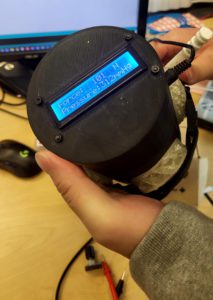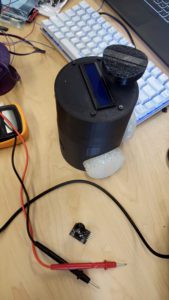Public Invention has raised $37,000 for a project run by Glia of Canada to make a completely open source desktop injection molded tourniquet, most immediately for Ukraine but usable by anyone. I’m proud of Glia and our support for them, and want to report a little on what they have done. One of our requirements as a fiscal sponsor is quarterly written reports, such as the one they just submitted for the Q1 2023. Like Public Invention, Glia is fiercely open and transparent in everything they do.
Glia already makes a good 3D printed tourniquet which can be purchased. However, an injection molded tourniquet would about halve the price and, equally importantly, allow them to be made at the rate of hundreds per day instead of dozens per day. By making the design for the mold itself fully open-source and reusable by anyone (you can find it here), they make the capital needed by any other firm to start production very low. Desktop injection molding has more startup costs but lower marginal costs than 3D printing, roughly costing a few thousands to set up instead of a few hundreds. (The tourniquet also requires sewing, of course.) Fundamentally, what they are doing is enabling a firm in a Low- and Middle-income country (LMIC) to start-up making a life-saving emergency device with attainable levels of capital.
This may seem odd for a firm like Glia, which is not technically a non-profit (though Public Invention is.) However, I believe Glia is a harbinger of new global approaches to manufacturing. Glia is pioneering a radical new approach to business. I’m writing this article so more people become aware of what they are doing.
Believe it or not, Glia welcomes a firm in Africa, for example, taking their designs and beginning their own production of the tourniquet as a money-making venture. In fact, they will advise you on how to do it; if you want to start such a business, please contact me <read.robert@gmail.com> or them!
Years of actual, sometimes bloody, experience informs the Glia tourniquet design. Dr. Loubani himself was shot in the leg by a sniper while in Gaza. I doubt anyone in the world knows more about tourniquet designs. For example, one important feature of the Glia design is that it works on women and children who have smaller limbs (generally) then grown men.
However, quality assurance requires both a quality design and quality manufacture. Glia has created a quality design, but worldwide manufacture by different parties based on an open source design raises the specific question: how do you trust the manufacture? Glia itself is setting up production in Poland with very knowledgeable injection molding experts (I’ve spoken to them), but how do you trust a new and different firm to correctly manufacture the Glia Tourniquet design?
To address this, Glia has taken yet another radical step: in conjunction with Prof. Joshua Pearce of Western Ontario University, they are building a tourniquet testing machine (open source, of course!) to allow simple third-party testing.
Here are some pictures of the test apparatus they are developing:


Public Invention co-founded the Global Open Source Quality Assurance System (GOSQAS) along with Open Source Medical Supplies and many other non-profits and universities specifically to promote widespread use of third-party testing of open source devices and provenance tracking.
Glia and GOSQAS together are trying to change the way the world addresses crises and manufactures emergency and medical devices. If you want to be a part of this global conversation, please contact me—let’s build a better future together.
Public Invention needs some money—we could use $100,000USD this year. Our donation page allow you to donate to us, including giving appreciate assets. By sending me a note at <read.robert@gmail.com>, you can earmark you gift specifically for the Glia Tourniquet project; they could use about another $15,000USD.
